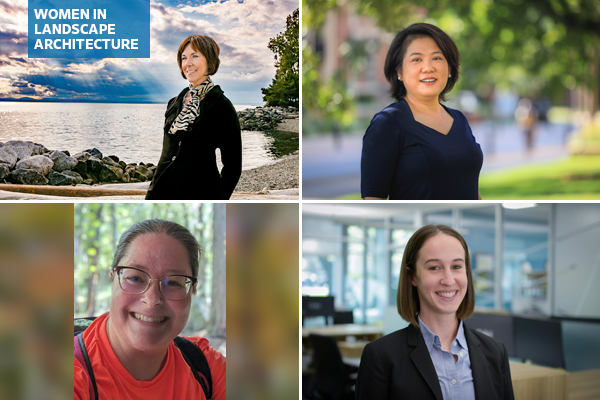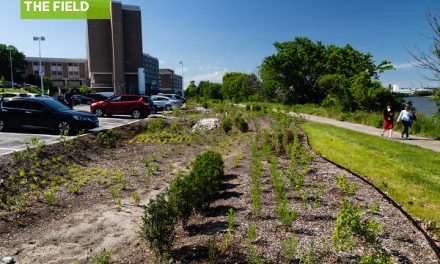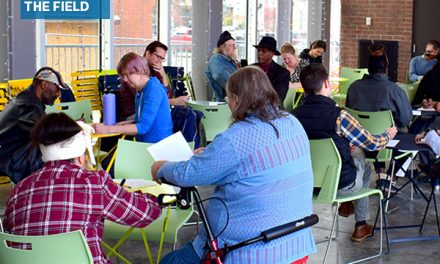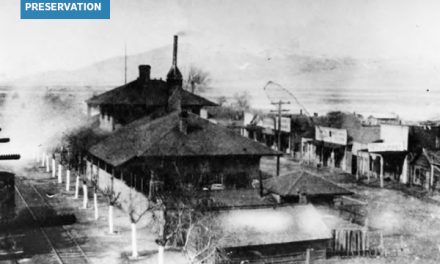ASLA’s Women in Landscape Architecture Professional Practice Network (WILA PPN) is sharing the next set of profiles of women in the profession (see last week’s right here). If you’d like to be featured, the PPN’s call for submissions will remain open, with profiles being shared on an ongoing basis.
Submit a WILA profile!
These profiles will appear on the PPN’s LinkedIn group, Facebook group, and here on The Field. This post includes Qing Lana Luo, ASLA, Caeli Tolar, ASLA, Jan Satterthwaite, ASLA, and Kristina Snyder, ASLA. Stay tuned for more WILA profiles as our celebration of women in landscape architecture continues.
Qing Lana Luo, ASLA
What inspired you to pursue a career in landscape architecture?
My path to landscape architecture was ignited by a profound affinity for design, nature, and the intricacies of urban landscapes. This profession seamlessly merges my enthusiasm for the outdoors with the ambition to forge meaningful, sustainable spaces amidst the urban sprawl. Central to my approach is the art of creative problem-solvingreimagining urban spaces as green, habitable zones that promote sustainability and enhance community life.

Throughout my career, I have contributed to several prestigious international firms, including EDSA (Beijing), CRJA (now known as IBI Placemaking), and Turenscape. Landscape architecture has been a vibrant canvas for my artistic expression, enabling me to mold living materials into spaces that not only enhance beauty but also foster connection and inspiration. Currently, as a professor at Oklahoma State University, I am dedicated to educating the next generation of landscape architects. I emphasize to my students that our field offers a direct avenue to impact both the environment and society by harmonizing aesthetics with functionality. Our work strives for designs that deeply resonate, embodying a rare fusion of creativity, environmental stewardship, and the principles of engineering and science. This passion drives my commitment to crafting spaces that seamlessly integrate the natural with the built environment.
Who are the female role models who have influenced your career?
Throughout my career in landscape architecture, the influence of role models has been pivotal, evolving as I navigated through various stages. In the beginning, professors and local practitioners sparked my interest, showcasing the power of innovation and resilience in design. As I delved deeper into the profession, I was inspired by leaders committed to sustainability and social responsibilities.
However, the most significant influence has been Carol R. Johnson, a legend and pioneer in the field. Carol’s groundbreaking work and leadership at CRJA set new standards for excellence in landscape architecture. Her visionary approach to blending natural systems with urban environments, along with her unwavering dedication to mentorship, profoundly resonated with me. Working closely with her, I was deeply inspired by Carol R. Johnson’s legacy of creativity, leadership, and advocacy for public spaces. This experience shaped my design approach and career trajectory, highlighting the invaluable role that female role models like Carol play in inspiring the next generation of landscape architects.
What advice do you have for other women pursuing a career in landscape architecture?
Follow your heart’s desires. Pursue the aspects of landscape architecture that resonate most deeply with you. Whether your passion lies in ecological restoration, urban design, or community engagement, let your interests guide your career path. The most fulfilling projects are those that align with your personal values and aspirations.
Develop your expertise. As you grow in your career, actively seek opportunities to deepen your knowledge and skills. Work closely with your firm and senior designers to gain insights into project management, client relations, and advanced design techniques. Developing a specialized area of expertise not only enhances your value as a landscape architect but also contributes to the richness and diversity of the field.
Get licensed early. Securing your landscape architecture license early in your career opens doors to greater opportunities and autonomy. While the process may seem daunting, licensure is a critical step in establishing your credibility and expertise. It prepares you for taking on significant projects and leadership roles within the profession.
Can you share with us a project you are particularly proud of and why?
In my career as a landscape architect, I’ve had the honor of contributing to a variety of prestigious projects, including designs for university campuses, urban parks, streetscapes, green roofs, and even international projects. Each has enriched my professional journey, but a recent endeavor particularly close to my heart is the columbarium memorial garden I developed in our college town in Oklahoma with my students.
One of recent projects stood out for its deep community service aspect. It adeptly addresses space efficiency in an urban context, providing a dignified resting place that maximizes limited cemetery land. The project aligns with eco-friendly practices by offering a sustainable alternative to traditional burials, reflecting a deep respect for the environment. Financial accessibility was a priority, making the memorial garden an affordable option for families, easing the economic burden often associated with commemorating loved ones. The design focused on personalization, allowing families to create individualized spaces within the columbarium for reflection and remembrance. This capacity for personalization not only honors those who have passed but also provides comfort to the living. Architecturally, the garden enhances the cemeterys landscape, offering a serene and beautiful environment for visitors. It stands as a testament to the community’s commitment to memory, legacy, and respect for the environment. This project embodies the essence of thoughtful landscape architecture showcasing the power of design to heal and bring people together, making it a project I am particularly proud of.
What advice would you give your younger self?
Embrace growth and resilience in design. In this ever-evolving field, setbacks are not roadblocks but opportunities for innovation. Each challenge is fertile ground for refining my designs and methodologies. Cultivate resilience by viewing obstacles as chances to grow and learn. Stay engaged with the latest sustainable practices and technological advancements to ensure my work remains impactful and relevant.
Seek mentorship. Especially in the early stages of my career, seek out mentors who can provide guidance, feedback, and shared experiences. Their insights will enrich my understanding of ecological design, urban planning, and client collaboration. Mentorship is a two-way street; be willing to both learn from and contribute to the professional community.
Stay grounded in purpose. Remember the profound impact landscape architecture can have on communities and the environment. Ground my work in a sense of purpose, seeking projects that align with my values and contribute positively to society. Let my passion for creating meaningful spaces drive my career trajectory.

Caeli Tolar, ASLA
What inspired you to pursue a career in landscape architecture?
I didn’t find out about landscape architecture until my senior year in high school. My mom’s friend was an urban planner and offered me a tour of her office. While planning wasn’t for me, I did get to meet a landscape architect while I was there…he was drawing with markers on a huge plan. That was definitely a draw for me: the mix of art, design, science, and construction.
Who are the female role models who have influenced your career?
Throughout my career, I’ve had the opportunity to work with many talented and strong female professionals. I am fortunate to be able to work with Laurie Hall, ASLA, who encouraged me to get involved in ASLA, inspires me to become a better designer, and has taught me how to be confident and authoritative despite how others may treat me as a woman in construction. Another female role model for me is Emily O’Mahoney, FASLA. Her energy and passion for the profession is an inspiration to me.

What advice do you have for other women pursuing a career in landscape architecture?
Be confident in yourself as a professional and a designer. Don’t be afraid to voice your opinions even if you’re the only woman or the youngest person in the room. Your opinions and ideas are valid.

Can you share with us a project you are particularly proud of and why?
I’m particularly proud of the Hotel Eleo & Rush Lake project. This project is located on the University of Florida Health Hospital campus and provides a place of respite for hospital staff, patients, and their families. The pond features native plantings and provides habitat for wildlife. Fountains within the center of the pond provide aeration and also a focal point, while also producing soothing sounds for visitors to the hotel and restaurant. I’m proud of this project because I see it being used on a daily basis and I enjoyed creating a space that people can enjoy.

What advice would you give your younger self?
Make sure to make time for your personal life and self-care. Your career is important but your mental health is more important!

Jan Satterthwaite, ASLA, PLA
What inspired you to pursue a career in landscape architecture?
My interest in landscape architecture has been a lifelong journey, first beginning with intuition and learning to read place by being immersed in nature as a child. Later it was leavened by observing the landscape through world travel experiences, freelance art, and living with cancer. While being treated for cancer and during my healing journey, I realized there had to be a connection between environmental and human health and I felt compelled to do something that addressed the determinants and intersection of health and ecology on a broad scale. My career and life interest has been finding ways that design can successfully influence, promote, and restore ecological and human health, while not losing sight of the user experience.
Who are the female role models who have influenced your career?
When I first started my studies in landscape architecture, there were far more men than women who were published and teaching. While reading Ecological Design: Inventing the Future (1994) I was intrigued to hear about Mary Catherine Batesons groundbreaking writings on womens lives. Bateson was an important and very forward design outlaw thinker of the 1960s. She believed design should be an interdisciplinary and inclusive process because our built and natural environments are interactive systems. She spoke of the organism that destroys its environment destroys itself and that really hit home for me. She felt humankind was always trying to build new material objects for a single finite cause, usually not understanding the systems we were impacting while trying to fix a problem. Human technologies throughout history have been based on a collaboration with living systems that were not fully understood. Through her inspirational writings and teachings, I learned we should look at the entire planet as a living being, much the way indigenous peoples have learned and practiced within their communities. Every being is interconnected and in this age of ecological consciousness, we need to learn what the earth is teaching us for now and into the future.
What advice do you have for other women pursuing a career in landscape architecture?
As we think about design and being designers for the future, we will need to think creatively about our careers as a metaphor. Because landscape architecture is a STEAM discipline, a metaphor may come from the arts or sciences, or it may come from the humanities. I like to think of my role in landscape architecture as similar to that of a musician, in the sense that musicians improvise. They look at familiar elements, combine them in new ways, and make each performance a creative process. Thus, being able to improvise throughout your career gives you moments for flexibility and responsiveness while our world continues to change.

Can you share with us a project you are particularly proud of and why?
Of the variety of projects I have worked onparks, mixed-use residential, educational, commercial, large-scale urban development, and therapeutic settingsthe client and project that meant the most to me was the site design and development for Tiny Tots Development Center. This early learning community located in the Rainier Valley, Seattle, WA, is home to a large African American and immigrant community with little access to nature and biodiversity. I took access to nature for granted having grown up in a rural area with nature all around me.

What was most striking to me during the design process was how the community did not realize they had lost their connection with nature. It was a process that happened slowly and silently over many years, what the environmental studies profession calls a slow natural disaster. Through design, we re-introduced nature to reestablish biological function and structure but were careful not to introduce an engineered monoculture planting design, taking an indigenous worldview as the basis for site design. The landscape design and restoration process brought in more than new plantings while reducing hard spaces. It brought in community healing and a new realityone mimicking natureand has already changed the learning opportunities for the kids. The landscape at Tiny Tots has and will continue to become a renewal of relationships between the people and the land.

Kristina Snyder, ASLA, PLA
What inspired you to pursue a career in landscape architecture?
My mom! She retired and became a master gardener. Then starting working again to run the country master gardener program. I was working at a magazine that covered master planned communities at the time. She told me about a landscape architect who had come as part of master gardener training and talked about designing master planned communities. I thought: wait! Someone designs this?! I can do that.
Who are the female role models who have influenced your career?
Susan Hatchell, FASLA, Emily O’Mahoney, FASLA, Vaughn Rinner, FASLA, Katie Kingery Page, ASLA, Lisa Donnelly, ASLA, Dale Yeager, and so many of my classmates at MLA school: Katie Parent Adams, Melissa Tufts, Gretchen Gigley, Beth Gillespie, and Julia Reed to name a few.

What advice do you have for other women pursuing a career in landscape architecture?
Love it. Be bold. Keep speaking up.
Can you share with us a project you are particularly proud of and why?
I’m proud of my work with the WILA PPN (ASLA Women in Landscape Architecture Professional Practice Network) since 2011. I won a volunteer service award (the ASLA Outstanding Service Award) at the ASLA Conference on Landscape Architecture in 2022 for that work. The part I am most proud of is pushing ASLA to start really looking at diversity in the professioncollecting the data to see how we are doing.

I also did the planting design on a pocket park which I like to watch. A lot has changed there in nearly 20 years, but it’s really neat to be able to check it out when I’m in town.
What advice would you give your younger self?
I was well into my 20s when I went to MLA school. So I did it just about right. The advice I give folks newly entering college/graduate school is study abroad. If you can swing the extra loans. Get out there. Be uncomfortable. Try to live like someone else. It’ll really broaden your design toolbox. (My thesis was on cross-cultural design so I might be biased.)

Submit a WILA profile!
2024 WILA Profiles:
Voices of Women in Landscape Architecture, Part 1
- Carolina Jaimes, ASLA
- Connie Scothorn, ASLA
- Emily Greenwood, ASLA
Voices of Women in Landscapes Architecture, Part 2
- Kathryn Talty, ASLA
- Aida Curtis, FASLA
- CeCe Haydock, ASLA
2023 WILA Profiles:
Women in Landscape Architecture Profiles, Part 1
- Alexandra Mei, ASLA
- Angelica Rockquemore, ASLA
- Sandy Meulners, ASLA
- SuLin Kotowicz, FASLA
Women in Landscape Architecture Profiles, Part 2
- Shuangwen Yang, Associate ASLA
- Heidi Hohmann, ASLA
- Tristan Fields, ASLA
- Joni Hammons, ASLA
- Sahar Teymouri, ASLA
Like this:
Loading…





